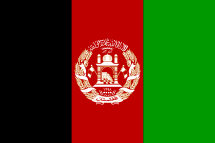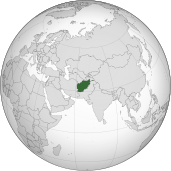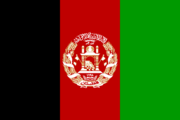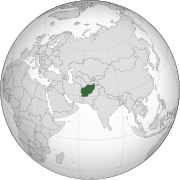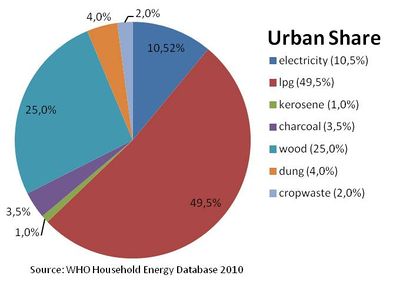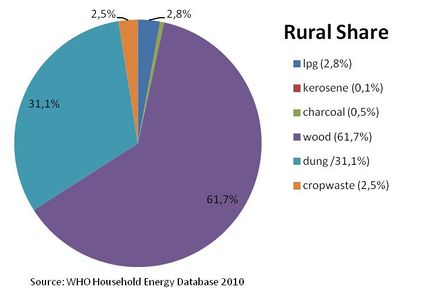Difference between revisions of "Afghanistan Energy Situation"
***** (***** | *****) m |
***** (***** | *****) m |
||
| Line 1: | Line 1: | ||
| − | {| cellspacing="0" cellpadding="0" border="1" style="width: 400px; | + | {| cellspacing="0" cellpadding="0" border="1" style="width: 400px; float: right" |
|- | |- | ||
| colspan="4" style="text-align: center" | '''Afghanistan'''<br/> | | colspan="4" style="text-align: center" | '''Afghanistan'''<br/> | ||
| Line 126: | Line 126: | ||
|} | |} | ||
<div style="clear: both"></div> | <div style="clear: both"></div> | ||
| + | <br/> | ||
| + | <div><br/></div><div> | ||
| + | {| border="0" cellspacing="1" cellpadding="5" align="right" style="font-size: 14px; width: 400px;" | ||
| + | |- | ||
| + | ! colspan="4" scope="col" style="text-align: center; background-color: rgb(79, 129, 189); width: 602px;" | <font color="#ffffff"><span style="line-height: 20.390625px;">Country Name</span></font> | ||
| + | |- | ||
| + | | rowspan="1" colspan="3" style="background-color: rgb(219, 229, 241); text-align: center; width: 250px;" | [[File:Flag of Afghanistan.svg|center|180px|Flag of Afghanistan|alt=Flag of _____.png]] | ||
| + | | style="background-color: rgb(219, 229, 241); text-align: center; width: 250px;" | [[File:Afghanistan (orthographic projection).svg|center|180px|Location of Afghanistan|alt=Location _______.png]] | ||
| + | |- | ||
| + | | colspan="3" style="background-color: rgb(219, 229, 241); width: 250px;" | '''Capital''' | ||
| + | | style="background-color: rgb(219, 229, 241); width: 250px;" | <br/> | ||
| + | |- | ||
| + | | colspan="3" style="background-color: rgb(219, 229, 241); width: 250px;" | '''Official Languages(s)''' | ||
| + | | style="background-color: rgb(219, 229, 241); width: 250px;" | <br/> | ||
| + | |- | ||
| + | | colspan="3" style="background-color: rgb(219, 229, 241); width: 250px;" | '''Government''' | ||
| + | | style="background-color: rgb(219, 229, 241); width: 250px;" | <br/> | ||
| + | |- | ||
| + | | colspan="3" style="background-color: rgb(219, 229, 241); width: 250px;" | '''President''' | ||
| + | | style="background-color: rgb(219, 229, 241); width: 250px;" | <br/> | ||
| + | |- | ||
| + | | colspan="3" style="background-color: rgb(219, 229, 241); width: 250px;" | '''Total Area''' | ||
| + | | style="background-color: rgb(219, 229, 241); width: 250px;" | <span data-scaytid="4" data-scayt_word="km2">km2</span> | ||
| + | |- | ||
| + | | colspan="3" style="background-color: rgb(219, 229, 241); width: 250px;" | '''Population''' | ||
| + | | style="background-color: rgb(219, 229, 241); width: 250px;" | (year) | ||
| + | |- | ||
| + | | colspan="3" style="background-color: rgb(219, 229, 241); width: 250px;" | '''Rural Population''' | ||
| + | | style="background-color: rgb(219, 229, 241); width: 250px;" | (year) | ||
| + | |- | ||
| + | | colspan="3" style="background-color: rgb(219, 229, 241); width: 250px;" | '''GDP (Nominal)''' | ||
| + | | style="background-color: rgb(219, 229, 241); width: 250px;" | US $ (year) | ||
| + | |- | ||
| + | | colspan="3" style="background-color: rgb(219, 229, 241); width: 250px;" | '''GDP Per Capita''' | ||
| + | | style="background-color: rgb(219, 229, 241); width: 250px;" | US $ (year) | ||
| + | |- | ||
| + | | colspan="3" style="background-color: rgb(219, 229, 241); width: 250px;" | '''Currency''' | ||
| + | | style="background-color: rgb(219, 229, 241); width: 250px;" | <br/> | ||
| + | |- | ||
| + | | colspan="3" style="background-color: rgb(219, 229, 241); width: 250px;" | '''Time Zone''' | ||
| + | | style="background-color: rgb(219, 229, 241); width: 250px;" | <br/> | ||
| + | |- | ||
| + | | colspan="3" style="background-color: rgb(219, 229, 241); width: 250px;" | '''Electricity Generation''' | ||
| + | | style="background-color: rgb(219, 229, 241); width: 250px;" | <span data-scaytid="5" data-scayt_word="TWh">TWh</span>/year (year) | ||
| + | |- | ||
| + | | colspan="3" style="background-color: rgb(219, 229, 241); width: 250px;" | '''Access to Electricity''' | ||
| + | | style="background-color: rgb(219, 229, 241); width: 250px;" | % | ||
| + | |- | ||
| + | | colspan="3" style="background-color: rgb(219, 229, 241); width: 250px;" | '''Wind energy (installed capacity)''' | ||
| + | | style="background-color: rgb(219, 229, 241); width: 250px;" | MW (year) | ||
| + | |- | ||
| + | | colspan="3" style="background-color: rgb(219, 229, 241); width: 250px;" | '''Solar Energy (installed capacity)''' | ||
| + | | style="background-color: rgb(219, 229, 241); width: 250px;" | MW (year) | ||
| + | |} | ||
| + | </div> | ||
| + | <br/> | ||
| + | |||
= Overview = | = Overview = | ||
| Line 220: | Line 277: | ||
<references /> | <references /> | ||
| + | [[Category:Country_Energy_Situation]] | ||
[[Category:Afghanistan]] | [[Category:Afghanistan]] | ||
| − | |||
Revision as of 15:35, 2 December 2013
| Afghanistan | |||
|
Capital |
Kabul (34° 32′ 0″ N, 69° 10′ 0″ E) | ||
|
Official language(s) |
Dari (Persian) and Pashto | ||
|
Government |
Islamic republic | ||
|
President |
Hamid Karzai | ||
|
Prime Minister |
| ||
|
Total area |
647,500 km2 | ||
|
Population [1] |
29.8 million | ||
|
Rural-Population |
23 million (77%) | ||
|
Urban-Population |
6.8 million (23%) | ||
|
Population Density |
43 Persons per km² | ||
|
Average Household Size |
11.4 | ||
|
GDP (nominal) |
$15.608 billion | ||
|
GDP per Capita |
$517 | ||
|
Currency |
Afghani (AFN) | ||
|
Time Zone |
CET (UTC+04:30) | ||
|
Calling Code |
+93 | ||
| Country Name | |||
|---|---|---|---|
| Capital | |||
| Official Languages(s) | |||
| Government | |||
| President | |||
| Total Area | km2 | ||
| Population | (year) | ||
| Rural Population | (year) | ||
| GDP (Nominal) | US $ (year) | ||
| GDP Per Capita | US $ (year) | ||
| Currency | |||
| Time Zone | |||
| Electricity Generation | TWh/year (year) | ||
| Access to Electricity | % | ||
| Wind energy (installed capacity) | MW (year) | ||
| Solar Energy (installed capacity) | MW (year) | ||
Overview
Geography and Climatic Conditions
- Arid to semiarid; cold winters and hot summers
- Mean temperature (°C min/max): 4.3/19.6 [2]
- Natural gas, petroleum, coal [1]
- Land area covered by forest: 1.3%
- Forest annual rate of change: 0% [3]
Socioeconomical Situation
Income Sources
- Agriculture: 79%
- Industry: 6%
- Services: 16%
National Energy Situation
Energy Supply
Electricity
Sources
- Hydropower 63,7%
- fossil fuels 35,3%
Stability
Energy Consumption
National Level
Electricity
Household Level
Percentage of energy types used for cooking in rural areas [4]
Percentage of energy types used for cooking in rural areas. [4]
Percentage of Population Using Solid Fuels
National: >95% [5]
Solid Fuel Use Impact on Health
Total annual deaths attributable to solid fuel use: 23900 persons
Percentage of national burden of diseases attributable to solid fuel use: 4.9% [6]
Access Rate
Electrification Rate
Electrification rate in households:[7]
- National: 23%
- Urban: 74%
- Rural: 3%
Policy Framework, Laws and Regulations
Relevant Institutions and Organisations
Existing Projects
Further Information
References
- ↑ 1.0 1.1 CIA - The World Factbook: https://www.cia.gov/library/publications/the-world-factbook/geos/af.html
- ↑ UN Data (2008): http://data.un.org/CountryProfile.aspx?crName=Afghanistan
- ↑ FAO (2011) The State of the World's Forest
- ↑ 4.0 4.1 WHO 2010: WHO Household Energy Database
- ↑ WHO (2006): Fuels for Life
- ↑ WHO (2006): Fuels for Life
- ↑ The National Risk and Vulnerability Assessment 2005, Kabul, Afghanistan. Cited in WHO (2009) The Energy Access Situation in developing Countries

